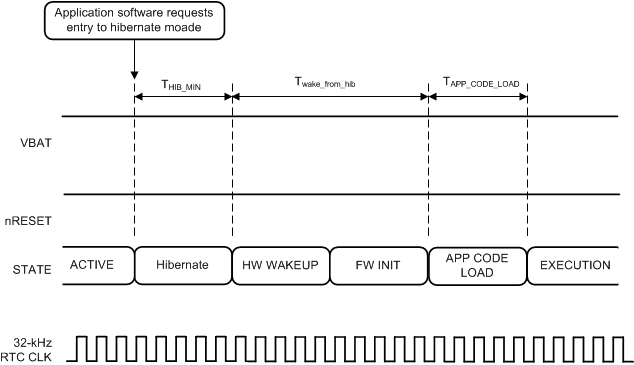SWRS215E April 2019 – December 2024 CC3235S , CC3235SF
PRODUCTION DATA
- 1
- 1 Features
- 2 Applications
- 3 Description
- 4 Functional Block Diagrams
- 5 Device Comparison
- 6 Pin Configuration and Functions
-
7 Specifications
- 7.1 Absolute Maximum Ratings
- 7.2 ESD Ratings
- 7.3 Power-On Hours (POH)
- 7.4 Recommended Operating Conditions
- 7.5 Current Consumption Summary (CC3235S)
- 7.6 Current Consumption Summary (CC3235SF)
- 7.7 TX Power Control for 2.4 GHz Band
- 7.8 TX Power Control for 5 GHz
- 7.9 Brownout and Blackout Conditions
- 7.10 Electrical Characteristics for GPIO Pins
- 7.11 Electrical Characteristics for Pin Internal Pullup and Pulldown
- 7.12 WLAN Receiver Characteristics
- 7.13 WLAN Transmitter Characteristics
- 7.14 WLAN Transmitter Out-of-Band Emissions
- 7.15 BLE/2.4 GHz Radio Coexistence and WLAN Coexistence Requirements
- 7.16 Thermal Resistance Characteristics for RGK Package
- 7.17
Timing and Switching Characteristics
- 7.17.1 Power Supply Sequencing
- 7.17.2 Device Reset
- 7.17.3 Reset Timing
- 7.17.4 Wakeup From HIBERNATE Mode
- 7.17.5 Clock Specifications
- 7.17.6 Peripherals Timing
- 8 Detailed Description
- 9 Applications, Implementation, and Layout
- 10Device and Documentation Support
- 11Revision History
- 12Mechanical, Packaging, and Orderable Information
Package Options
Mechanical Data (Package|Pins)
- RGK|64
Thermal pad, mechanical data (Package|Pins)
- RGK|64
Orderable Information
7.17.4 Wakeup From HIBERNATE Mode
Note:
The 32.768kHz crystal is enabled by default when the chip goes into HIBERNATE mode.
Table 7-17 lists the software hibernate timing requirements.
Table 7-17 Software Hibernate Timing Requirements
| ITEM | NAME | DESCRIPTION | MIN | TYP | MAX | UNIT |
|---|---|---|---|---|---|---|
| THIB_MIN | Minimum hibernate time | 10 | ms | |||
| Twake_from_hib(1) | Hardware wakeup time plus firmware initialization time | 50(2) | ms | |||
| T_APP_CODE_LOAD | App code load time for CC3235S | CC3235S | Image size (KB) × 1.7ms | ms | ||
| App code load time for CC3235SF | CC3235SF | Image size (KB) × 0.06ms | ||||
(1) Twake_from_hib can be 200ms on rare occasions when calibration is performed. Calibration is performed sparingly, typically when exiting Hibernate and only if temperature has changed by more than 20°C or more than 24 hours have elapsed since a prior calibration.
(2) Wake-up time can extend to 75ms if a patch is downloaded from the serial Flash.
Figure 7-8 shows the timing diagram for wakeup from HIBERNATE mode.
 Figure 7-8 Wakeup From HIBERNATE Timing Diagram
Figure 7-8 Wakeup From HIBERNATE Timing Diagram